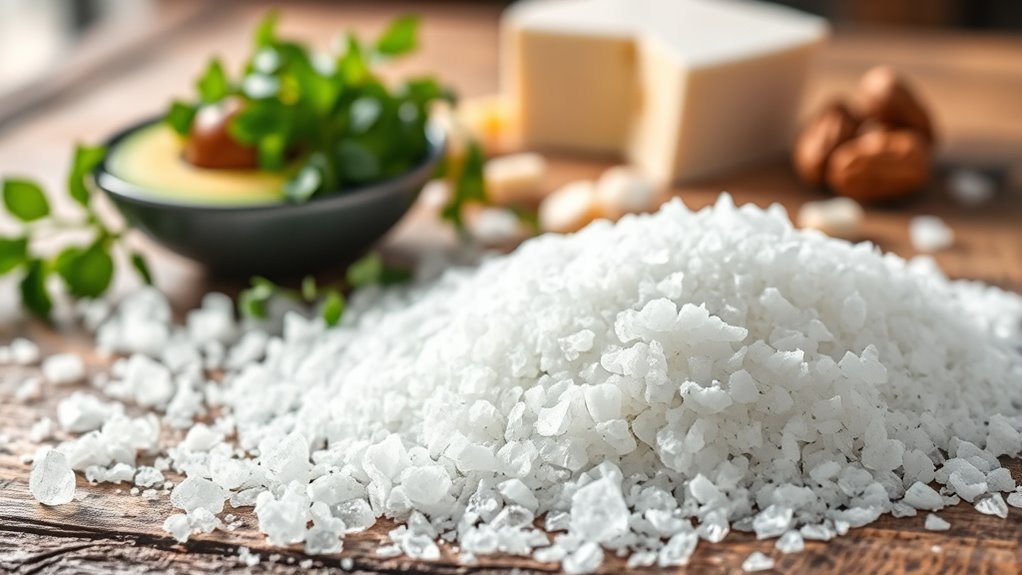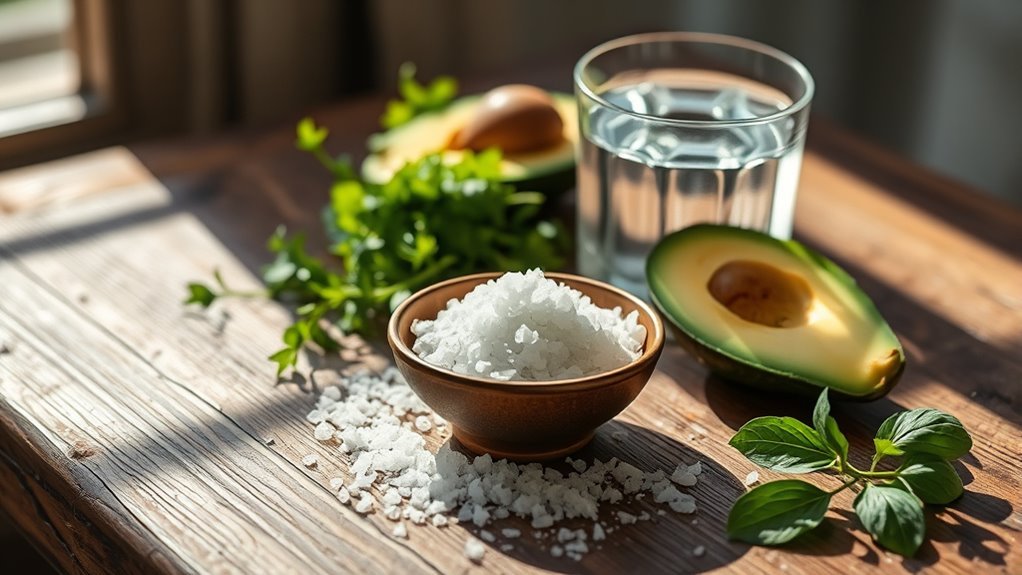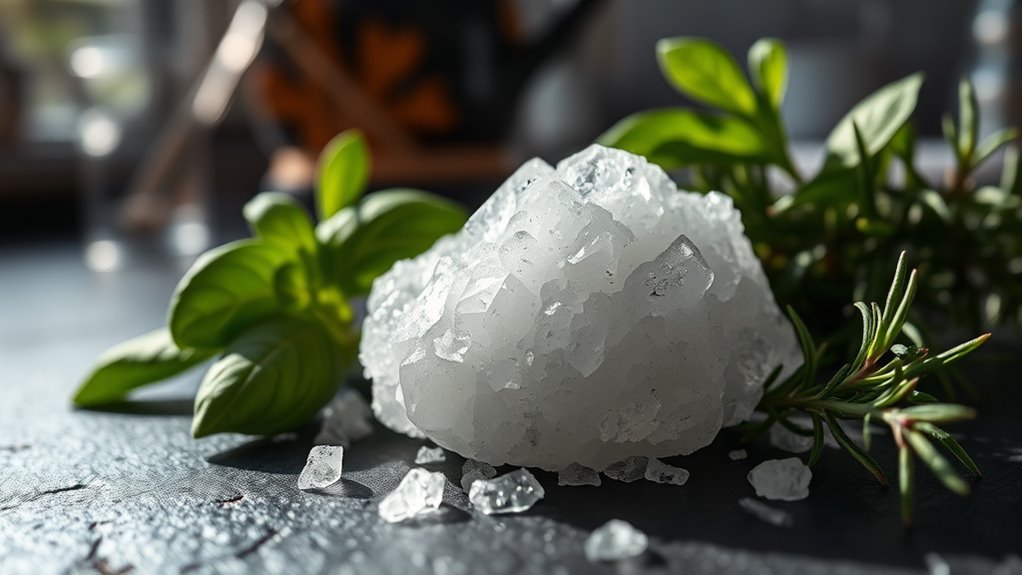Yes, salt is essential on a keto diet. It helps maintain sodium levels and supports hydration and electrolyte balance, which are important for your overall health. When you lower carb intake, your sodium levels can drop, so monitoring your salt intake becomes critical. Using high-quality salts not only enhances flavor but also provides necessary minerals. If you’re curious about how to properly balance your salt intake and choose the right types, there’s more to explore on this topic.
Understanding the Role of Salt in the Body

While many people think of salt primarily as a seasoning, it actually plays an essential role in maintaining various bodily functions. Sodium, a key component of salt, is critical for sodium absorption in your body. It helps regulate fluid balance, ensuring that your cells remain hydrated and function effectively. Additionally, salt contributes to mineral balance, which is fundamental for muscle contractions and nerve signaling. When you’re on a keto diet, your body may lose more sodium due to reduced carbohydrate intake, making it even more important to monitor your salt consumption. By understanding salt’s role, you can better support your body’s needs while enjoying the freedom of a low-carb lifestyle. Embracing this knowledge can empower you to make informed dietary choices.
The Importance of Electrolytes on a Keto Diet

When you commence a keto diet, it’s important to pay attention to your electrolyte levels, as the reduction in carbohydrate intake can lead to a significant drop in essential minerals like sodium, potassium, and magnesium. Maintaining electrolyte balance is essential for overall well-being and can prevent symptoms like fatigue and cramps. Here’s a quick overview of sodium sources and other electrolytes:
| Electrolyte | Sodium Sources |
|---|---|
| Sodium | Table salt, broth |
| Potassium | Avocados, spinach |
| Magnesium | Nuts, seeds |
| Calcium | Leafy greens, dairy |
How Low-Carb Diets Affect Sodium Levels

As you decrease your carbohydrate intake on a low-carb or keto diet, your body undergoes several adjustments, including changes in sodium levels. During keto adaptation, your kidneys excrete more sodium, leading to potential deficiencies if you’re not mindful of your sodium sources. Without the carbohydrates that typically hold onto water in your body, you might find yourself needing more salt to maintain balance. It’s essential to incorporate adequate sodium into your meals, whether through seasoning or high-sodium foods like bone broth. Monitoring your sodium intake can help prevent symptoms like fatigue or muscle cramps, ensuring you stay energized and healthy on your low-carb journey. Always listen to your body and adjust accordingly for ideal wellness.
Myths About Salt and High Blood Pressure
You might think that all salt is bad for your blood pressure, but the relationship is more complex than that. While excessive sodium intake can contribute to hypertension, many people misunderstand how much salt they actually consume and its effects on health. Understanding these nuances can help you make more informed dietary choices.
Salt’s Role in Hypertension
While many people believe that salt directly causes high blood pressure, the relationship is more nuanced than it appears. Sodium misconceptions often stem from oversimplified conclusions in hypertension studies. It’s important to recognize that not everyone is equally affected by salt intake. For some individuals, particularly those with certain genetic predispositions or pre-existing conditions, excess sodium can indeed contribute to higher blood pressure. However, for others, moderate salt consumption doesn’t greatly impact their levels. It’s also worth noting that factors like diet quality, physical activity, and stress play essential roles in hypertension. So, before drastically cutting salt, consider your unique health situation and consult with a healthcare professional to make informed decisions about your sodium intake.
Misunderstanding Sodium Intake
Many people fall prey to misconceptions about sodium intake and its direct connection to high blood pressure, often oversimplifying a complex issue. While it’s true that excessive sodium can contribute to hypertension, it’s essential to recognize that individual responses to sodium vary. Sodium myths suggest that all salt is harmful, but moderate intake can offer salt benefits, like maintaining fluid balance and supporting nerve function. In fact, some studies indicate that low-sodium diets might not be beneficial for everyone, especially those who are physically active. It’s important to focus on overall dietary patterns and lifestyle choices rather than solely blaming sodium for high blood pressure. Embracing a balanced approach allows you to make informed choices about your health.
Choosing the Right Type of Salt for Keto
When you’re on a keto diet, choosing the right type of salt can enhance both flavor and health benefits. Options like Himalayan pink salt and sea salt not only provide essential minerals but can also help maintain electrolyte balance. Understanding these differences can aid you in making informed choices that support your keto journey.
Types of Keto-Friendly Salt
Choosing the right type of salt is essential for those following a keto diet, as not all salts are created equal. Himalayan Pink salt offers trace minerals, enhancing flavor while supporting your mineral intake. Sea salt, especially flaky varieties, provides a natural crunch that’s perfect for seasoning. If you prefer a coarser texture, Kosher salt is a great choice, often used in cooking for its ease of handling. Black salt adds a unique flavor profile, making it a gourmet option. Flavored salts, like garlic or herb-infused, can elevate your dishes without extra carbs. Finally, smoked salt adds a rich, smoky taste, perfect for grilled foods. Explore these options to find what suits your preference while enjoying your keto journey.
Health Benefits of Salt
Salt plays a significant role in your overall health, especially on a keto diet. It’s essential to choose the right sodium sources to reap the health benefits while maintaining your well-being. Here are some key advantages of including salt in your diet:
- Electrolyte balance: Helps maintain proper hydration and nerve function.
- Blood pressure regulation: Supports cardiovascular health when consumed in moderation.
- Enhanced flavor: Makes meals enjoyable, encouraging you to stick to your diet.
- Muscle function: Aids in muscle contractions, preventing cramps and fatigue.
The Flavor Benefits of Adding Salt to Your Meals
While many people might overlook it, adding salt to your meals can greatly enhance flavor profiles and elevate your culinary experience. Salt serves as a fundamental ingredient in flavor enhancement, bringing out the natural tastes of ingredients. It can transform a bland dish into something vibrant and delicious, making your meals more enjoyable.
Using salt creatively allows you to experiment with different cuisines and flavors, fostering culinary creativity. From balancing sweetness in desserts to highlighting savory notes in meats and vegetables, salt plays a pivotal role. Remember, it’s not just about adding salt; it’s about finding that perfect balance to elevate your dishes. Embrace the freedom to explore various techniques and seasonings, and let salt be your ally in the kitchen.
How to Balance Salt Intake on a Keto Diet
When following a keto diet, managing your salt intake becomes important for maintaining electrolyte balance and overall well-being. Here are some practical tips for balancing your sodium sources:
Managing your salt intake is crucial on a keto diet for optimal electrolyte balance and well-being.
- Incorporate high-quality sea salt in your meals for flavor and minerals.
- Choose low-carb foods that naturally contain salt, like olives and pickles.
- Monitor your fluid intake, as hydration affects sodium levels.
- Listen to your body; if you’re feeling fatigued or cramping, assess your salt intake.
Finding the right balance can enhance your keto experience without sacrificing flavor or health. Remember, while salt is essential, moderation is key to avoid potential health issues. Enjoy your meals while keeping your salt intake in check!
Signs of Sodium Deficiency and How to Address It
Although sodium is often overlooked, its deficiency can lead to various health issues, especially for those on a keto diet. You might experience sodium cravings, fatigue, headaches, or muscle cramps—common deficiency symptoms. These issues arise because low sodium can affect your hydration effects, leading to dehydration. To address this, consider increasing your salt intake responsibly or incorporating electrolyte supplementation to restore balance. Choosing high-quality sea salt or electrolyte powders can help, but always listen to your body. It’s crucial to maintain freedom in your dietary choices while ensuring you meet your sodium needs. By staying informed about sodium’s role, you can support your health effectively on your keto journey.
Frequently Asked Questions
Can I Use Sea Salt Instead of Table Salt on Keto?
Yes, you can use sea salt instead of table salt on keto. Sea salt benefits include trace minerals that can enhance flavor and provide some nutritional value. When comparing salt types, sea salt often has a coarser texture and might be less processed than table salt. Both types can fit into your keto lifestyle, but sea salt can be a more natural choice, giving you that freedom to explore flavors without compromising your diet.
Does Salt Help With Keto Flu Symptoms?
Picture a ship steering through stormy seas; without proper ballast, it risks capsizing. Similarly, maintaining sodium balance is essential during your keto journey. Salt can indeed help alleviate keto flu symptoms by providing essential electrolyte support. As your body adjusts to burning fat for fuel, you may lose more sodium through urine. Adding salt to your meals can ease headaches and fatigue, helping you sail smoothly toward your health goals without feeling weighed down.
How Much Salt Should I Consume Daily on Keto?
On a keto diet, you should aim for about 3,000 to 5,000 mg of sodium daily to maintain proper electrolyte balance. This increased sodium intake helps counteract the loss of electrolytes that often occurs on keto. Remember, individual needs can vary, so listen to your body. If you’re feeling fatigued or experiencing keto flu symptoms, you might need to adjust your salt intake. It’s all about finding what works best for you!
Is Pink Himalayan Salt Better Than Regular Salt for Keto?
Pink Himalayan salt isn’t necessarily better than regular salt for keto, but it does offer some Himalayan benefits. It contains trace minerals that can enhance flavor and may provide additional health perks. However, both salt variations serve the same purpose in maintaining electrolyte balance, which is vital on a keto diet. Ultimately, it’s about personal preference and how your body responds. Just remember to use salt in moderation, regardless of the type.
Can Salt Disrupt Ketosis or Weight Loss Progress?
Salt itself won’t disrupt ketosis or hinder weight loss, but it’s essential to maintain a balanced sodium intake. Too little salt can lead to electrolyte imbalances, especially on a low-carb diet, while excessive sodium might cause water retention. Aim for a moderate intake to support your sodium balance without compromising your progress. Remember, it’s all about finding what works best for your body while enjoying the freedom that your dietary choices provide.


